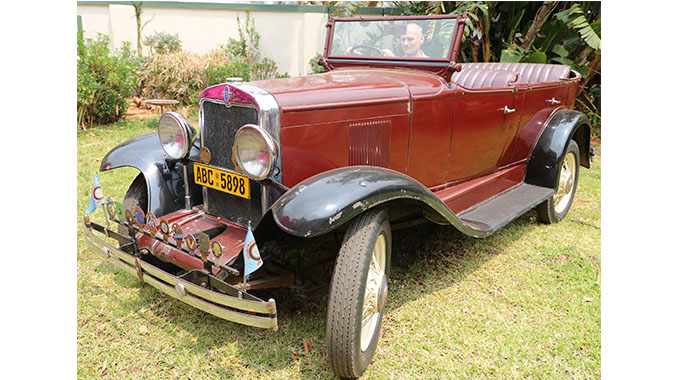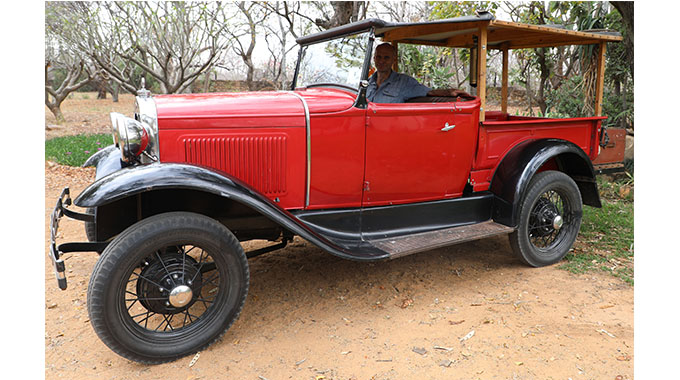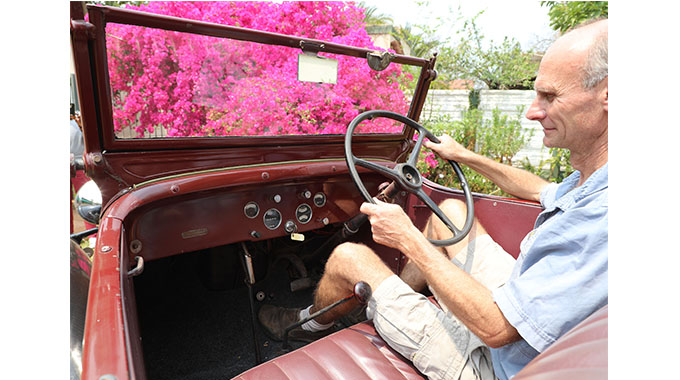Make and car model defines the driver

Mashudu Netsianda, Senior Reporter
JUST as “the hat makes the man,” to quote the title of the late famous German graphic artist and poet Max Ernst’s 1920 collage, so has the motorcar — over the course of a century — become the accessory that defines a driver.
As a symbol, the automobile speaks eloquently about its owner, and sometimes not in flattering terms. Generally, the make and model of a car defines a status symbol or the owner’s social and economic standing.
Top-of-range latest models, especially those driven by the rich and famous, seem to ratchet up the onlookers’ response.
For Mr Martin Sherfield (48), a Bulawayo-based vintage car enthusiast who owns a 1930 Ford Model and a 1930 Chevrolet, the script reads differently.

A vintage car is, in the most general sense, an old automobile, and in the narrower senses of car enthusiasts and collectors, a car from the period of 1919 to 1930.
While the generality of automobile fans seem to be infatuated by the latest trends in the industry, Mr Sherfield has never been moved by the changing inclinations in the motor industry. For him, when it comes to the wheels, he prefers vintage cars.
Mr Sherfield bought his first car, a Ford Model A in 1999. When he bought it, it was in an ugly shape, but he managed to restore it to its original state although it took him four years to completely rebuild it.
“I bought my first vintage car, a 1930 Ford Model and it was completely in pieces. I rebuilt it completely from scratch and it took me four years. I had to import some of the spare parts from the United States,” he said.
Mr Sherfield has two vintage cars, in his collection and one of them, a 1930 Chevrolet, which is a six-cylinder (2,8 litre) petrol engine, is only used for hire during weddings among other events.
“Many people hire my car for milestone events, especially couples to be married request my vintage car for their wedding procession and my charges depend on hours ranging from US$100 to US$350,” he said.
“The Chevrolet is strictly for weddings and I seldom use it outside weddings because I don’t want it to wear and tear because it is costly to maintain. In fact, it is my money earner hence I have to look after it.”
His Ford Model A is his favourite car, which is specifically reserved for personal use. He has actually gone an extra mile to install modern sound systems and air-conditioning among other new pieces of technology.
The Ford Model A was the second biggest success for the Ford Motor Company after its more famous predecessor, the Model T.

First sold on December 2, 1927 it replaced the Model T which had been in production for 18 years. Model A production ended in March 1932, after 4,8 million had been made in all body styles.
Mr Sherfield, who seems to be an expert in vintage cars, said the Model A was the first Ford to use the standard set of driver controls with conventional clutch and brake pedals, throttle, and gear shift.
“Previous Fords used controls that had become uncommon to drivers of other makes and a rear-view mirror was optional. The Model A was also the first car to have safety glass in the windshield,” he said.
Mr Sherfield said the furthest he has driven his Ford Model A was during his five-week road trip to Botswana.
“I use my Ford Model A for travelling with my family and I have done quite a number of road trips. We have been to Hwange National Park and Great Zimbabwe a couple of times and embarked on several tours to Victoria Falls and Matopos National Park. The longest distance that I covered was 4 000km when I travelled to Botswana and the trip took us five weeks,” he said.
Mr Sherfield developed a strong passion for vintage cars at a tender age. Although, he is not a qualified automobile mechanic, his father was.
“I developed this craving for vintage cars at a tender age. I really don’t know where it came from because my father certainly didn’t have any vintage car although he was a mechanic by trade. I vividly recall when I was a small boy, I used to admire these vintage cars each time I saw them moving around,” he said.
Besides vintage cars, Mr Sherfield loves old tractors, and a couple of them in his collection including old manual petrol pumps, gramophones and old stationary engines
Mr Sherfield said it was through daily interaction with his father and observing him fixing cars that he eventually developed basic skills in mechanics. The marvel of vintage cars goes beyond personal collections.
Today, he is not only a vintage car enthusiast, but an accomplished builder of such cars.
“Generally, it usually takes me up to two years to work on a single vintage car since I have to be specific with parts, the body, the interior and all other areas. The complete rebuilds that I have done so far in my career include three 1930 Ford Model A, 1926 Ford Model T, two 1954 Land Rovers, Morris 8, a model of the 1950s,” he said.
Mr Sherfield bought his Chevrolet in 2003 for US$2 000 in Harare where it had been neglected for a long time and parked under a tree.
“The owner of the car died and left it in the hands of his wife, but she never did anything to it and she too died, leaving the vehicle with her daughter who also did nothing. She needed to sell the house and contacted me, saying she was selling the old car. I made an offer of US$2 000 and bought it,” he said.
Mr Sherfield said they used to organise a series of runs to Matopos about 10 years ago, together with other vintage car collectors.
“We have done vintage expos for a very long time, but nowadays we can’t because there are few left. Ten years back, we used to drive to Matopos in a single file showcasing our vintage cars, but they are now too few, maybe two or three left in Bulawayo,” he said.
He said the first car to arrive in the country was a French Gladiator in 1902. It was a single cylinder chain driven with battery ignition.
Mr Sherfield said one of the biggest challenges that vintage car owners face when it comes to rebuilding them revolves around their re-registration as most of them won’t be having log books.
“Normally, they don’t have log books as most of them would have been lost many years ago. So, to try and get them licenced is quite a challenge if not almost impossible,” he said.
The rich history vintages carry once prompted the Zimbabwe National Road Administration (Zinara) to exempt them from paying road licences after lobbying by vintage car clubs.
This concession exempting cars that are over 40 years old was in place since 2011, an initiative that was embraced by owners of classic vehicles as recognition of the increasing historical significance of their vehicles.
The exemption was, however, scratched seven years later in February last year after a directive from the Ministry of Transport and Infrastructural Development.
It was withdrawn because the concession had never been formally legislated and, with the new political dispensation in place, all ministries were instructed to act strictly in accordance with the law.
What remains now are free licences for vehicles manufactured up to January 1, 1931, which are exempted under the Vehicle Registration and Licensing Act Chapter 13:14 of 2001. Vintage car owners are however engaging the Ministry to legislate the license exemption. — @mashnets










Comments